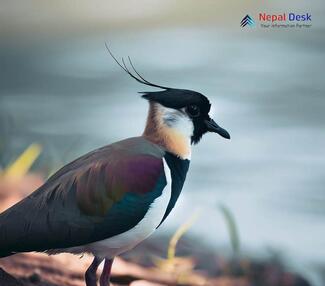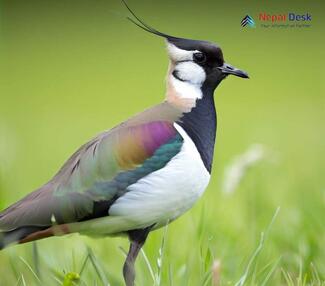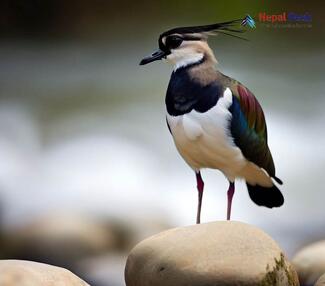The northern lapwing (Vanellus vanellus) is a medium-sized wading bird belonging to the family Charadriidae, which includes plovers, dotterels, and lapwings. It is the only species in the Vanellus genus. Its scientific name comes from the medieval Latin words vanellus meaning "little fan" about its wing shape, and the species name vanellus meaning "lapwing".
Lapwings are ground nesting birds known for their crest, rounded wings, short tail, and evocative flight display. Northern lapwings have a wingspan around 70–87 cm. Their backs and upper wings range from metallic green to purple or bronze, with blackheads and breast bands contrasting starkly with their white underbellies. During the breeding season, lapwings develop remarkable fringed crests and black coronal stripes.
Genetically, northern lapwings have four pairs of chromosomes. Studies of mitochondrial DNA sequences have helped scientists trace the evolutionary history and migration patterns of Vanellus species. The ancestral lineage of lapwings is believed to have originated in central Asia, later dispersing and diversifying across Europe, Asia, and Africa. More research is needed to fully map out the phylogenetic relationships between different plover groups.
Flying behavior and capacity
Northern lapwings are graceful and acrobatic fliers, capable of rapid wing beats and sudden changes of speed and direction. Their rounded wings allow for maneuverability and help them patrol open habitats as they search for insect prey.
During the spring breeding season, male lapwings perform spectacular aerial displays to attract females. These tumbling flight displays incorporate streamlined dives, broad-winged ascents, and zigzagging swoops close to the ground. The air rushing over specially modified wing feathers makes a distinctive "drumming" or "song" - giving lapwings alternative common names like peewit, pewit, or teewitt.
Powered by strong breast muscles attached to a large-keeled sternum, northern lapwings are efficient flyers with a cruising airspeed of around 50-65 kmph. They can reach top recorded speeds of 70-80 km/h while migrating or evading predators. Sustained fast flight is fueled by fat accumulated during premigratory hyperphagia or excessive overeating.
Wings adapted for lift enable lapwings to hover in mid-air or hang suspended - coming to an abrupt stall before changing directions. Such agile flight lends northern lapwings an advantage when defending nests or distracting potential predators through disruption flights and alarm calls. Their characteristic wavering flight style gave rise to the scientific name Vanellus, meaning "little fan".
With light bodies of around 130-330 grams and loaded flight power of 15-20 watts, northern lapwings can migrate enormous distances. Some populations fly nonstop for 2000-4000+ kilometers between their European breeding range to wintering grounds in Africa and Asia. These marathon migratory journeys are aided by innate navigation systems attuned to geomagnetic fields.
That covers some key details on the flying behavior and aeronautical capacities that enable northern lapwings to thrive from the tundra to the tropics. Let me know if you would like me to elaborate on any area further or move on to another topic.
Ecological importance
As prey species, northern lapwings represent an abundant food source sustaining predators across their migration routes and wintering grounds. Key lapwing predators in Nepal include marsh harriers, steppe eagles, jackals, and even the rare Bengal tiger.
Through fecal droppings and inefficient foraging, lapwings also facilitate significant nutrient redistribution. Nitrogen and phosphorus deposits enrich refuge wetland ecosystems across Nepal's lowlands, increasing soil fertility and boosting net primary productivity.
By stirring and aerating mud in search of invertebrate prey, the probing feeding behavior of lapwings brings oxygen deeper down and churns nutrients back toward the surface. Such bioturbation supports healthier intertidal ecosystems and benefits other aquatic species.
As abundant keystone organisms within grassland and wetland food chains, northern lapwings likely exert a disproportionate influence on community dynamics across stopover habitats during migration periods when they are most numerous.
The presence of northern lapwings serves as a signal species indicating the general health of ephemeral pools, rice paddies, and short grass pastures preferred on their migratory path through countries like Nepal. Declines may reflect concerning environmental changes.
Tracking the phenology of lapwing migrations in Nepal also allows insights into the timing and productivity of the Arctic system where they ultimately breed. Being highly sensitive to climate, lapwings represent an important bioindicator species across Eurasia.
Identification and remarkable features
Key identification features and remarkable traits
- Distinctive rounded black and white plumage - black crowns, breast bands, and bills contrast markedly with white faces and underbellies even at a distance
- Fine reddish legs, most apparent during flight or while walking
- Long, thin, and somewhat downturned black bills used for sensitive probing in mud
- Striking head crests and elongated feathers forming frills on the neck and chest during breeding season
- Bright yellow facial wattles become more pronounced just before the spring migration back to nesting areas
- In flight, broad rounded wings and a short tail along with a white rear back make northern lapwings easily recognizable
Standout remarkable features
- Their evocative aerobatic mating displays incorporating swoops, hovers, and spirals
- Lapwing flocks wheeling in fast unison to mob predators or humans straying near their ground nests
- The capacity for amazingly long and rapid nonstop migratory journeys covering thousands of kilometers
- Cryptic camouflaged summer plumage adaptively helps to incubate lapwings blend into the tundra
- Northern lapwing's signature wavering flight style resembles the flapping of a fan, hence their old scientific name “Vanellus”
The combination of angular black and white plumage accents, graceful flight maneuvers, and vocal peewit calls make northern lapwings a hard bird to misidentify when encountered on South Asian grasslands during winter months.
Nesting behavior and strategy
Since Nepal lies south of the Himalayas, beyond the temperate breeding range, northern lapwings do not nest within the country. The high peaks block further passage preventing access northwards to favored Arctic and sub-Arctic nesting habitats.
However, northern lapwings do occupy Nepal’s lowlands and foothills as important wintering grounds and migratory staging areas. From September through March, non-breeding lapwing flocks roost and forage in wet grasslands and rice paddies across the Terai plain.
While in Nepal, lapwings engage in year-round pair-bonding displays but do not advance to actual mating or nest-building activities. Northerly migrating flocks depart in spring to distant breeding locations on remote Russian and Scandinavian tundras.
There on open moist ground with sparse vegetation, mated pairs scratch shallow nest depressions lined with grasses and feathers. Females lay clutches of 4 speckled olive eggs which both parents incubate for around 28 days before hatching.
So while northern lapwings that overwinter in Nepal prepare through flock bonding rituals, they do not progress to full nesting and rearing behaviors. Actual breeding is reserved for summer habitats far north after completing their annual migration.
Breeding Behaviour
Northern lapwings begin the breeding process by returning to ancestral Arctic nesting grounds starting in late April. Competing males perform elaborate aerial displays and loud "pee-wit" calls to attract a mate. Once paired, the monogamous couple defends a large nesting territory.
Both sexes contribute to scraping a shallow, rudimentary nest depression on open wet tundra with scant vegetation. The female then lays a clutch of usually four olive-brown blotched eggs over about a week in May or early June.
Both parents share equally in incubating the eggs for around 27-31 days before hatching in early July when arctic summer offers more abundant resources. To warm the eggs, lapwings have specialized lower-body brooding feathers. Parents trade-off nest duties, rotating every hour or so.
They fiercely defend the nest and later gangly precocial chicks, trying to draw interlopers away by faking broken wings. Lapwings may re-nest up to three times if early clutches fail due to harsh weather or predation during the narrow breeding window before southbound migration.
So while conducted thousands of miles away, understanding this tundra mating and nesting life cycle still provides helpful biological context for lapwings visiting Nepal solely in migration and wintering phases between September and March annually.
Feeding Habits
Northern lapwings have versatile feeding habits, taking advantage of seasonal food sources as they migrate across continents. Here are some details on their diet and foraging behavior:
Lapwings employ visual hunting techniques, using their large eyes placed high on the sides of the head to scan for movement. Their slender black bills are sensitive enough to probe mud in search of invertebrate prey but strong enough to crush hard-shelled beetles and snails.
During the breeding season in spring and summer, lapwings feed primarily on insects, worms, and other invertebrates abundant in wet meadows and agricultural fields across Europe and Northern Asia. Foraging flocks rush in to snatch earthworms and leatherjackets driven to the surface by plowing or rain.
At estuaries and intertidal mudflats where lapwings overwinter, they consume polychaete marine worms, mollusks like tiny clams and snails, and crustaceans including shrimp, amphipods, and isopods. Shoreline feeding patterns follow tidal cycles, with lapwings more actively probing exposed sediments during low tide.
Seeds and plant material become a bigger part of the northern lapwing diet during the fall and winter months. Flocks may gather at stubble fields and grasslands rich in waste grain and seeds. Their seasonal shift to more plant-based nutrition before migratory periods likely helps accumulate fat deposits required for long flights.
For omnivorous northern lapwings, dietary flexibility allows them to thrive across diverse northern habitats prone to extreme weather shifts. Let me know if you’d like me to describe anything further regarding the feeding behavior or digestive system adaptations that enable their broad palate and migrations.
Migration
As Nepal lies along the Central Asian flyway, it serves as an important migratory passage and wintering area for northern lapwings breeding further north. While lapwings do not nest in Nepal due to the Himalayas barrier, the country sees an influx of visiting birds in the non-breeding season.
From September through November, thousands of northern lapwings pass through Nepal as part of their southbound autumn migrations towards the Indian subcontinent. Key wetland stopover sites include Koshi Tappu Wildlife Reserve and wet grasslands across the Terai plains bordering India.
Up to 15,000 lapwings overwinter in Nepal's lowlands and valley bottoms mainly from December to February. Important wintering grounds include Lumbini, Chitwan National Park, and the surrounding Nawalparasi district with seasonal marshes and alluvial grasslands.
Come March, lapwing flocks take off again bound northwards for distant Arctic nesting sites. Brief spring stopovers provide rest on their journey through Nepal back across the Himalayas along ancestral flyways towards Central Asia and Siberia beyond.
Habitat and Hotspots in Nepal
During their overwintering months and migration stopovers from September to March, northern lapwings primarily frequent open lowland landscapes across the Terai plains in southern Nepal.
Major lapwing wintering hotspots include wet grasslands and marsh areas like those found in Lumbini and the wildlife reserves of Koshi Tappu and Chitwan National Park. Loose flocks scatter to forage in muddy or flooded fields and along oxbow lakes and meandering rivers across the inner Terai valleys.
Another regional stronghold lies further west in the grasslands spanning the Rupandehi, Kapilvastu, and Nawalparasi districts. The World Wildlife Fund has designated this intermediate zone between the Terai and Churia foothills as a critical habitat for non-breeding lapwings.
Wetlands fed by northward-flowing rivers descending from the Siwalik Hills attract significant congregations. The combination of swampy terrain and adjoining dry short-grass pastures suits habitat needs for both roosting and foraging.
Outside protected wildlife areas, lapwings also commonly occupy fallow agriculture fields, shifting their distribution by seasonal cultivation and grazing patterns. Flooded rice paddies and recently tilled fields offer suitable mud-probing grounds when irrigation canals overflow during winter months.
Overall, Nepal's mosaic of grasslands, marshland, and arable land found along the subtropical Gangetic plains provides dependable refuge on the migration highway for these high arctic nesting shorebirds.
Global Range
The ancestral lineage of lapwings is believed to have originated in central Asia over 1.5 million years ago during the Early Pleistocene. From there, dispersal waves colonized suitable open habitats across Eurasia and Africa following ice age retreats.
Today, the breeding range centers across Northern Europe and Northern Asia above 60° north latitude up to the Arctic Ocean shores. Expanding grasslands and wet tundra habitats after the last Ice Age allowed rapid expansion northwards to occupy suitable nesting grounds.
Currently, the northern lapwing enjoys one of the largest non-fragmented breeding ranges of any wader species, spanning over 16 million square kilometers from Iceland to northeastern Siberia. Countries with significant nesting populations include Norway, Sweden, Finland, Russia, Mongolia, and into Northern China.
Outside the summer breeding season, northern lapwings vacate the harsh Arctic winter for more hospitable latitudes further south. Different populations fan out across Europe, Northern Africa, the Middle East, India, and Southeast Asia along established flyways.
Nepal falls directly along the Central Asian migratory path used by birds that nest further north in Siberia and migrate through to Myanmar and continental Southeast Asia. Northern lapwings only occupy Nepal briefly during winter layovers or migration transit between September and March.
Identifying Sex
- No clear plumage differences distinguish males from females year-round. Subtle variations may indicate sex during breeding when colors intensify.
- Displaying males exhibit bolder black-and-white patterning when courting potential mates in spring. Smaller and duller female lapwings tend to get overlooked.
- On average males measure slightly larger in overall body size. But extensive overlap means even biometric data like wing length shows no reliable sex differences.
- The most reliable method involves laparotomy to directly inspect gonads. Given risks, sexing based on behavior like courtship displays or copulations is preferred for field studies.
Potential Confusion Species
- Spur-winged lapwings also called spur-winged plovers (Vanellus spinosus) overlap in sub-Saharan Africa wintering grounds. Noticeably larger with reddish facial skin and yellow wattles.
- Grey-headed lapwings (Microsarcops cinereus) breed further southeast in Asia. Darker grey rather than blackheads when not breeding. Found around wetlands.
- Long-billed plovers (Charadrius placidus) frequent similar habitats in Asia and have brighter orange legs/eye rings but preferred habitats differ.
In Nepal during non-breeding winter months, the northern lapwing's distinctive rounded wings and bold black-and-white plumage minimize chances of confusion with other wading birds occupying grasslands and paddies in the lowlands.
IUCN Status
- Currently, the northern lapwing is evaluated as a species of Least Concern on the IUCN Red List of Threatened Species.
- Global populations are estimated at anywhere between 5.7 to 19 million individual birds distributed across an enormously extensive range.
- As such a widespread migratory species, northern lapwings are not presently vulnerable to extinction risks. However, researchers still recommend continued monitoring.
Best Season
- The prime season for spotting northern lapwings in Nepal runs mid-December through February during the peak of the overwintering period when their numbers are highest.
- Stopover sites may still yield good sightings, especially in early March right before the spring migration departure back to Russian and Scandinavian Arctic breeding areas.
Spotting Techniques
- Scan open grasslands, wet meadows, and marshy areas of protected lowland reserves like Koshi Tappu Wildlife Refuge. Look for black-and-white speckled flocks of 20-50 foraging on mudflats or taking flight calling.
- Paddies and agricultural fields in the flat inner Terai valleys and foothills districts offer alternative sites to potentially encounter widely dispersed groups or lone wandering individuals overwintering in the region.
- Identify northern lapwings at a distance by their rounded wings, short tails, bold black-and-white color patterns, and wavering flight style with rapid wing beats.




